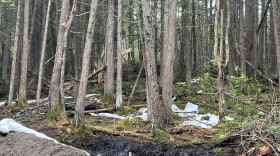This coverage is made possible through a partnership between IPR and Grist, a nonprofit environmental media organization.
Wooden debris still blankets swaths of northern Michigan hit by this spring’s ice storm.
State Rep. Parker Fairbairn (R-Harbor Springs) represents the 107th District, which includes much of that area. Fairbairn is asking the state Department of Natural Resources to lift remaining restrictions on the collection of fuelwood — wood for personal use, like firewood. The changes would allow people to collect as much as they want from roadside areas in state forests.
“Let's not inhibit people from being able to get firewood and get biofuel to — whether it's heating their homes or what have you," Fairbairn said. "Let's just get these woods cleaned up as fast as possible so we mitigate and lessen the risk of fire in the future," he added, referring to the amount of debris created by the storm that could dry up and serve as fuel for forest fires.
DNR foresters have issued guidelines for how people should manage different species of trees after the storm. For example, they recommend that people prioritize clearing pine tree debris before June to help control bark beetle populations and the spread of fungal disease, but that they wait to handle oak tree debris until after mid-July to avoid spreading oak wilt, a fatal fungal disease. They also advise using firewood locally rather than transporting it long distances to avoid spreading pests and disease to new places.
The state requires permits to collect wood for personal use in certain areas of state land. Only wood that is dead, fallen and within 200 feet of a road can be taken.
In an April 28 letter, Fairbairn asked the DNR to eliminate the $20 permit fee, the 90-day limit on the permit and the cap on how much wood can be collected, though he didn’t ask for any changes to where that collection can take place.
Forestry meetings this week:
- Emmet Conservation District is hosting a talk about forestry and recovering from the ice storm on Wednesday, May 14, at 5:30 p.m. at Pellston High School. Representatives from the local timber industry will be there as well.
- Otsego Conservation District is holding a similar event on Thursday, May 15, at 6 p.m. at the E-Free Church at 1649 M-32 in Gaylord.
The DNR’s website says limits on where wood can be gathered are there to protect the forests, help improve soil, provide plant and wildlife habitat and avoid conflicts with the timber industry.
“I think the permit’s still important, but I think we want to maximize the amount of people who are getting them and participating and cleaning up our woods,” Fairbairn said.
Fuelwood is measured in cords, which are stacks 4 feet wide, 4 feet tall and 8 feet long. The DNR has already doubled the amount of wood people can collect in 12 counties hit by the storm, from five cords to 10.
One Michigan State University Extension post from 2012 estimated that most homes use five or six cords per winter for heating, though there’s a lot of variation.
No one from the DNR was available for an interview, though a spokesperson said the department was reviewing Fairbairn’s request and working on a response, though they didn’t know when that would be sent.
Fairbairn co-sponsored a bill to provide $100 million in state disaster funding to the region. The House passed that bill last week. One hope is that it could direct more federal dollars to communities impacted by the storm.






